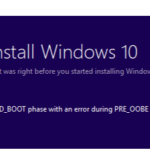This tutorial contains instructions to fix the Windows 10 Upgrade Error 0xC1900101 – 0x4001E: “The installation failed in the SECOND_BOOT phase with an error during PRE_OOBE operation”.
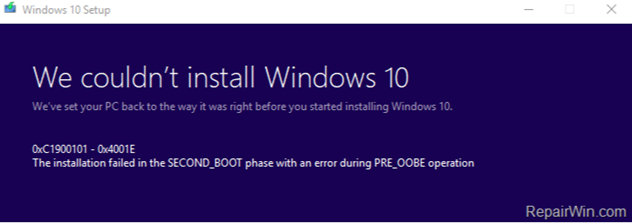
Windows 10 Upgrade Problem 0xC1900101 – 0x4001E in details: When you try to upgrade Windows 10 to the latest version (build) or when you try to upgrade your system from Windows 7 or 8.1 to Windows 10, the installation stops with error “We couldn’t install Windows 10 – 0xC1900101 – 0x4001E – The installation failed in the SECOND_BOOT phase with an error during PRE_OOBE operation” and then reverts back to the previous Windows version.
Additionally, the “setuperr.log” file from “C:$Windows.~BTsourcepanther” folder, shows the error “FatalError [0x090001] PANTHR Exception (code 0xC0000005: ACCESS_VIOLATION) occurred at 0x00007FFF8DA34643 in C:WindowsSystem32provengine.dll (+000000000000494B)”.
How to FIX Windows 10 Update Error 0xC1900101 – 0x4001E “Installation failed in the SECOND_BOOT phase with an error during PRE_OOBE operation”
Usually, the error code 0xC1900101 – 0x4001E during the Windows 10 upgrade, indicates a problem with an incompatible device, driver or program on the system. So, before you continue to apply the methods below, check and try the following:
1. First of all, make sure that the Date & Time settings are correct.
2. Then, ensure that you have enough free space. Your device requires at least 16 GB of free space to upgrade a 32-bit OS, or 20 GB for a 64-bit OS. To free up disk space use Disk Cleanup.
3. Install the latest drivers for all the devices on your system, especially for the Ethernet & the Wireless adapter (if any). *
4. Disconnect all USB drives or other USB devices that you don’t need.
5. If you ‘re using a third-party antivirus program, then temporarily uninstall it.
6. Disable the Hard Drive Encryption (If enabled).
7. Finally, before restarting your computer to install the update, disconnect from the network. (e.g. Unplug the Ethernet cable or disable the Wi-Fi) adapter).
* Note: If after applying the instructions in this article, the Windows 10 Upgrade Installation still fails, proceed and update also the BIOS (Firmware) on your system.
Method 1. Run the Windows Update Troubleshooter.
The first method to fix the Windows 10 update error 0xC1900101 – 0x4001E, is to run the Windows Update Troubleshooter.
1. Navigate to Windows Control Panel, set the ‘View By’ to Small icons and open Troubleshooting.
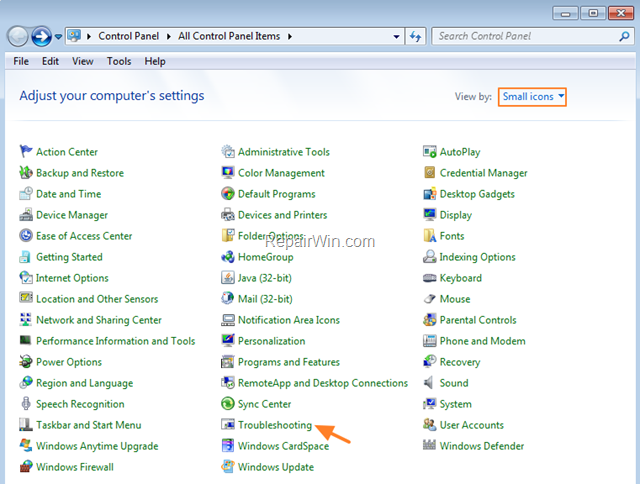
2. In Troubleshooting options, click Fix problems with Windows Update.

3. Click Next to troubleshoot Windows update problems.

5. When the troubleshooting process is complete, close the troubleshooter and restart your PC.
6. Check for updates.
Method 2. Delete the SoftwareDistribution Folder.
The “C:WindowsSoftwareDistribution“, is the location where Windows store the Windows Updates. Many times this folder becomes corrupted and you must re-create it in order to download updates and install from scratch. To rebuild (re-create) the “SoftwareDistribution” folder follow the steps below:
Step 1: Stop Windows Update Service.
1. Open Windows Services control panel: To do that:
- Press Windows
 + R keys to open the run command box.
+ R keys to open the run command box. - In the Search box, type: services.msc & click OK.
- (Accept the UAC warning if appears).
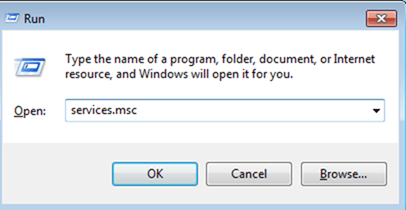
2. In Services control panel locate the Windows Update service. 3. Right-click on Windows Update service and select “Stop”.
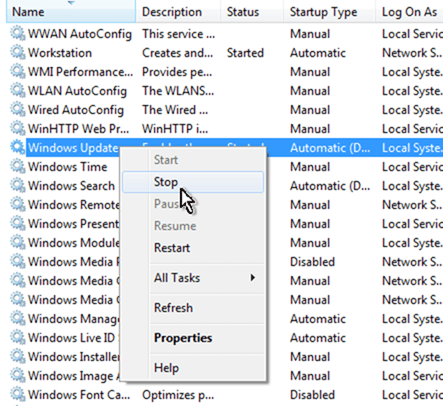
Step 2: Delete the SoftwareDistribution folder.
1. Open Windows Explorer and navigate to: C:Windows folder.
2. Find and Delete the “SoftwareDistribution” folder (or rename it. e.g. to “SoftwareDistributionOLD”) .
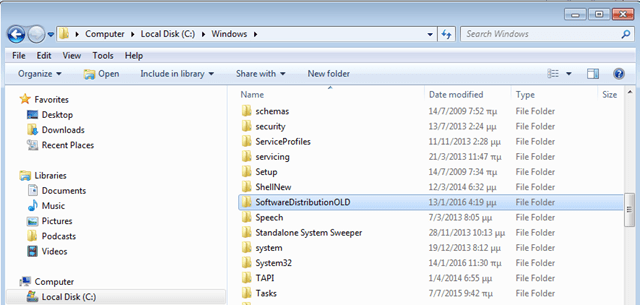
Step 3: Start the Windows Update Service.
1. Open Windows Services control panel.
2. Right-click on Windows Update service and select “Start”.
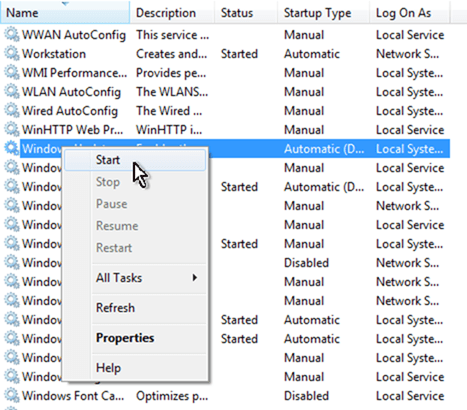
Step 4: Check and Install Windows 10 Update.
1. Navigate to Settings -> Update and Security and click Check for Updates.
Method 3. Disable the Intel Virtualization Technology.
1. Enter BIOS settings.
2. Disable the Intel VT-d in Advanced settings -> Chipset.
3. Save and Exit from BIOS settings.
4. Try to upgrade Windows 10.
Method 4. Rename ‘Provisioning’ Registry Key and ‘C:WindowsProvisioning’ folder.
Another method to resolve the error “0xC1900101 – 0x4001E / ACCESS_VIOLATION) occurred at 0x00007FFF8DA34643 in C:WindowsSystem32provengine.dll”, is to rename (or delete) the following registry key and folder (in bold):
- HKEY_LOCAL_MACHINESOFTWAREMicrosoftProvisioning
- C:WindowsProvisiong
To apply this method, follow the instructions below:
1. Press Windows ![]() + R keys to open the run command box.
+ R keys to open the run command box.
2. Type regedit and press Enter to open the Registry Editor. *
* WARNING! Modify Registry with your Own Risk! Serious problems might occur if you modify the registry incorrectly. These problems might require that you reinstall the operating system.
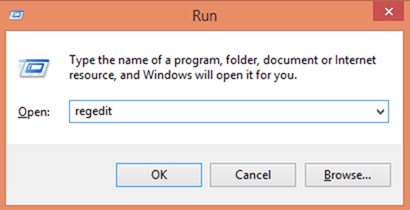
3. In Windows registry editor locate the following key:
- HKEY_LOCAL_MACHINESOFTWAREMicrosoftProvisioning
4. Right click on Provisioning key and select Export
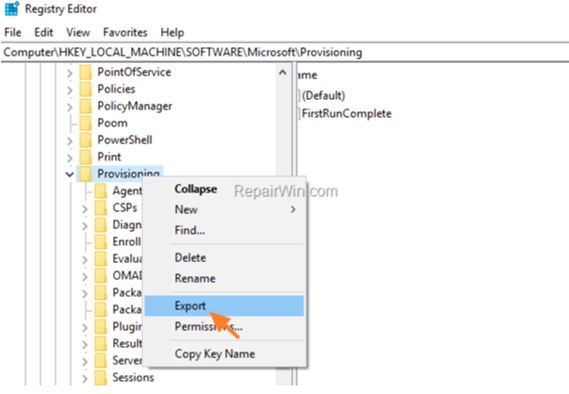
5. Type a name for the exported registry file (e.g. “Provisioning”) and save the file to your desktop. *
* Note: If something goes wrong during the process, double click the exported registry file to restore the registry in the current state.

6. Then, Right click at the Provisioning key and click Permissions.
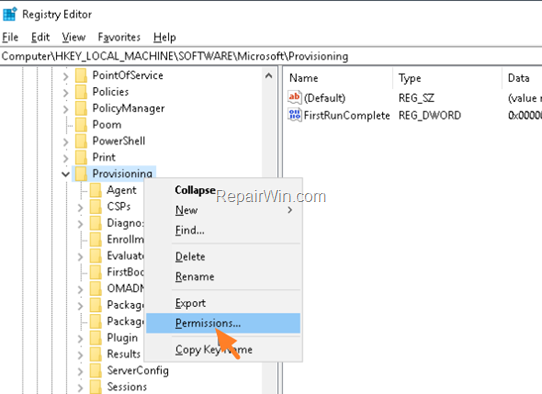
7. Click Advanced and then click Change owner.
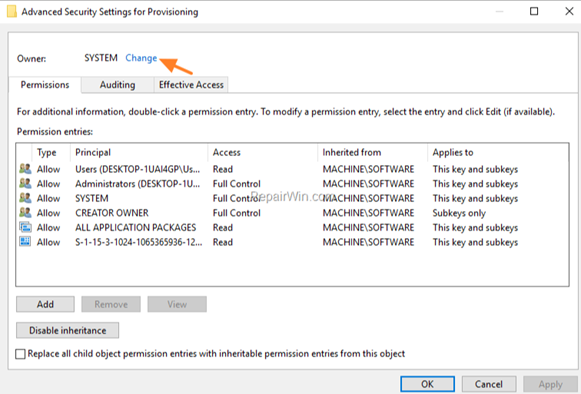
8. At “Enter the name to select” box, type Administrators and click OK.
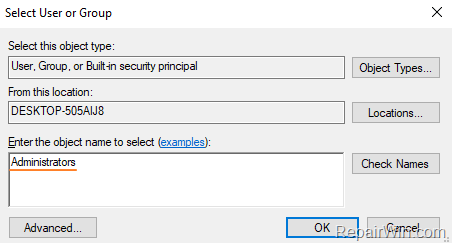
9. Choose to Replace owner on subcontainers and objects and then click Apply.
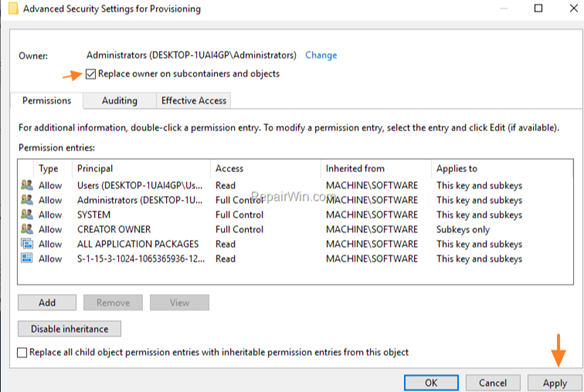
10. Then press the Disable inheritance button.
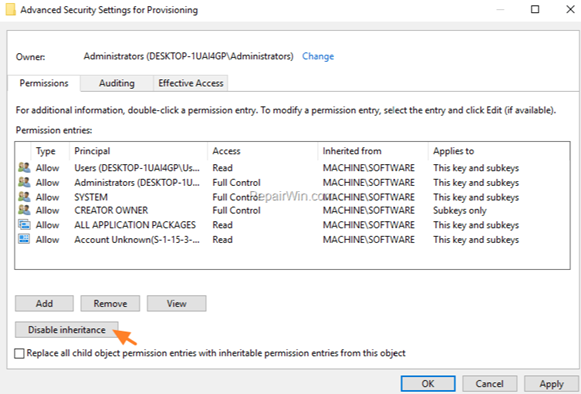
11. On the ‘Block inheritance’ window, click Convert inherited permissions into explicit permissions on this object.
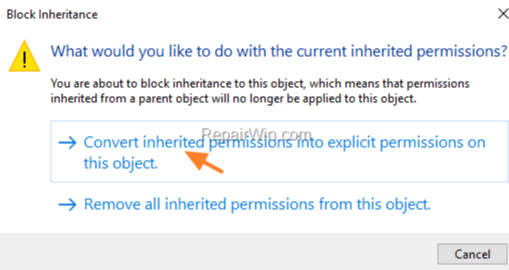
12. Then, select Replace all child objects permissions entries with inheritable permissions entries from this object and click Apply.
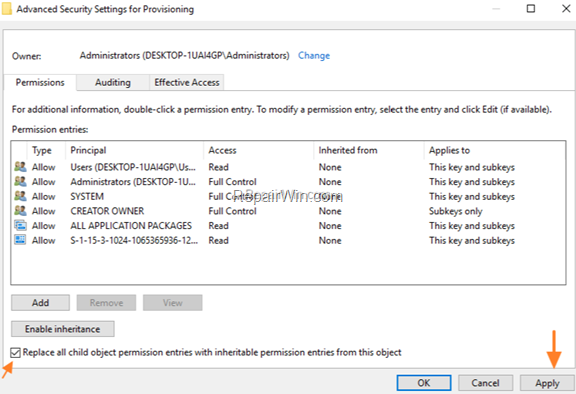
13. At the ‘Windows Security’ window click Yes.
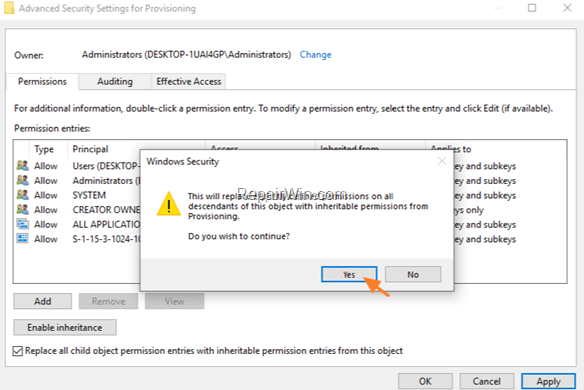
14. Click OK two (2) times to close the Permissions Properties.
15. Now right click at the Provisioning registry key and select Rename.
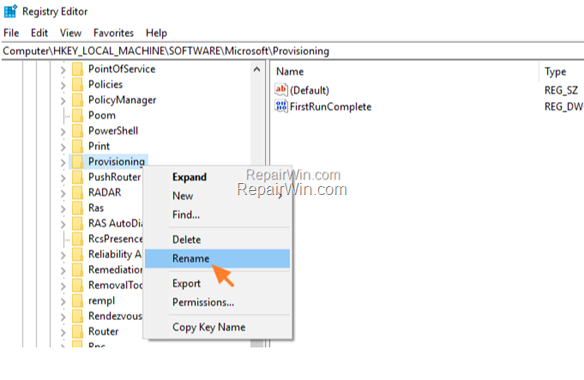
16. Change the key name to Provisioning.OLD and press Enter.
17. Close Registry Editor.
18. Open Explorer and rename the C:WindowsProvisioning folder to C:WindowsProvisioning.OLD.
19. Restart your computer.
20. Try to upgrade Windows 10. *
* Note: After upgrade, you can securely delete the “Provisioning.OLD” registry key and the “C:WindowsProvisioning.OLD” folder if you like to.
Method 5. Repair Windows 10.
The final method to resolve Windows 10 Update installation problems, is to repair Windows 10 with In-Place Upgrade.
That’s all folks! Did it work for you? Please leave a comment in the comment section below or even better: like and share this blog post in the social networks to help spread the word about this solution.

